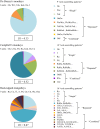Social complexity parallels vocal complexity: a comparison of three non-human primate species
- PMID: 23847565
- PMCID: PMC3705190
- DOI: 10.3389/fpsyg.2013.00390
Social complexity parallels vocal complexity: a comparison of three non-human primate species
Abstract
Social factors play a key role in the structuring of vocal repertoires at the individual level, notably in non-human primates. Some authors suggested that, at the species level too, social life may have driven the evolution of communicative complexity, but this has rarely been empirically tested. Here, we use a comparative approach to address this issue. We investigated vocal variability, at both the call type and the repertoire levels, in three forest-dwelling species of Cercopithecinae presenting striking differences in their social systems, in terms of social organization as well as social structure. We collected female call recordings from twelve De Brazza's monkeys (Cercopithecus neglectus), six Campbell's monkeys (Cercopithecus campbelli) and seven red-capped mangabeys (Cercocebus torquatus) housed in similar conditions. First, we noted that the level of acoustic variability and individual distinctiveness found in several call types was related to their importance in social functioning. Contact calls, essential to intra-group cohesion, were the most individually distinctive regardless of the species, while threat calls were more structurally variable in mangabeys, the most "despotic" of our three species. Second, we found a parallel between the degree of complexity of the species' social structure and the size, diversity, and usage of its vocal repertoire. Mangabeys (most complex social structure) called twice as often as guenons and displayed the largest and most complex repertoire. De Brazza's monkeys (simplest social structure) displayed the smallest and simplest repertoire. Campbell's monkeys displayed an intermediate pattern. Providing evidence of higher levels of vocal variability in species presenting a more complex social system, our results are in line with the theory of a social-vocal coevolution of communicative abilities, opening new perspectives for comparative research on the evolution of communication systems in different animal taxa.
Keywords: Cercocebus sp.; Cercopithecus sp.; acoustic individual distinctiveness; acoustic variability; evolution of communication; social system; vocal repertoire.
Figures





References
-
- Beecher M. D. (1989). Signalling systems for individual recognition: an information theory approach. Anim. Behav. 38, 248–261 10.1016/S0003-3472(89)80087-9 - DOI
LinkOut - more resources
Full Text Sources
Other Literature Sources
Miscellaneous

